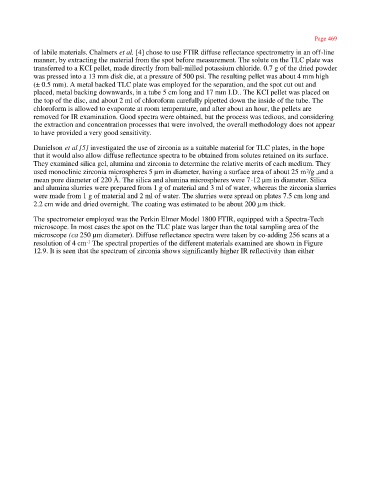Page 484 - Tandem Techniques
P. 484
Page 469
of labile materials. Chalmers et al. [4] chose to use FTIR diffuse reflectance spectrometry in an off-line
manner, by extracting the material from the spot before measurement. The solute on the TLC plate was
transferred to a KCI pellet, made directly from ball-milled potassium chloride. 0.7 g of the dried powder
was pressed into a 13 mm disk die, at a pressure of 500 psi. The resulting pellet was about 4 mm high
(± 0.5 mm). A metal backed TLC plate was employed for the separation, and the spot cut out and
placed, metal backing downwards, in a tube 5 cm long and 17 mm I.D.. The KCI pellet was placed on
the top of the disc, and about 2 ml of chloroform carefully pipetted down the inside of the tube. The
chloroform is allowed to evaporate at room temperature, and after about an hour, the pellets are
removed for IR examination. Good spectra were obtained, but the process was tedious, and considering
the extraction and concentration processes that were involved, the overall methodology does not appear
to have provided a very good sensitivity.
Danielson et al [5] investigated the use of zirconia as a suitable material for TLC plates, in the hope
that it would also allow diffuse reflectance spectra to be obtained from solutes retained on its surface.
They examined silica gel, alumina and zirconia to determine the relative merits of each medium. They
used monoclinic zirconia microspheres 5 µm in diameter, having a surface area of about 25 m /g ,and a
2
mean pore diameter of 220 Å. The silica and alumina microspheres were 7-12 µm in diameter. Silica
and alumina slurries were prepared from 1 g of material and 3 ml of water, whereas the zirconia slurries
were made from 1 g of material and 2 ml of water. The slurries were spread on plates 7.5 cm long and
2.2 cm wide and dried overnight. The coating was estimated to be about 200 µm thick.
The spectrometer employed was the Perkin Elmer Model 1800 FTIR, equipped with a Spectra-Tech
microscope. In most cases the spot on the TLC plate was larger than the total sampling area of the
microscope (ca 250 µm diameter). Diffuse reflectance spectra were taken by co-adding 256 scans at a
resolution of 4 cm The spectral properties of the different materials examined are shown in Figure
-1
12.9. It is seen that the spectrum of zirconia shows significantly higher IR reflectivity than either

